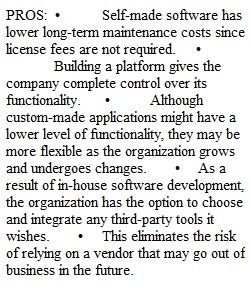


Q Week 4: Team Project - Module 4 Team Project! 3 From 2022-FALL-HPEM-5340.060 ***This is a Team Project, with 2 people per team, the teams are assigned as groups*** Read Chapter 5 first!! Pairs will be randomly assigned. You will then need to discuss with your teammate the task below. Project will be done with both people on the team. Please draft one response from both of you for this task. This is essentially a thought exercise, more focused on paying attention to factors that are critical (beyond the price tag) for decisions about healthcare tech and infrastructure. Here is the scenario: You and your teammate work for a mid-sized to large not for profit health system, that includes a hospital and clinics. Currently, the system has an integrated health record system that works for the most part well. Except, the scheduling module is abysmal. You are not sure if the company who owns the platform you used built this themselves or bought someone else's and never quite finished making it run seamlessly with the rest of the system or exactly what the issue is. The vendor is not willing to put any significant resources into redoing the scheduling component, and the the patches they have released have not been helpful. Rather than replace the entire platform, a decision has been made to find an alternative to the scheduling module. Your internal IT shop wants to build it themselves. They do not have experience in this specific type of software development though. They are a mid-sized shop, which is consistent with the size of the health system. They think the have the bandwidth to develop this scheduling app/module. There are several vendors that have packages that look promising as well. They can either sell you the software, or you can subscribe to it, along the lines of the application service provider mentioned on page 83. You can house the software "on premises" (your own system's servers) or "off premises" (think cloud or the vendor's proprietary servers, most will be cloud though). You and your partner will make a decision on what to do. Please note, there are no right or wrong conclusions. This can be argued either way with the information presented. It is an exercise about thinking about how to manage technology decisions. Assumptions: • You have adequate budget to do either, but this falls into a capital budget, which is reviewed yearly. Maintenance budget will fall into normal operational budgets • Your IT shop are smart and industrious, but not experienced with this type of work. They work hard, but have some bandwidth at the current workload • Interoperability is critical. Whatever solution needs to work with the rest of the platform • Security is critical. • On-Premises and off-premises solutions both have advantages and disadvantages. • Reliability is critical, along with that is who might you be more comfortable with when something happens, your own IT shop, or a vendor? We are looking for a clear, concise review of factors you would consider, weight the relative importance of things like cost, control, local server, remote server, reliability, interoperability, and what steps you really would take to ensure you get what you need. What are the "must haves" for a new platform? What are "nice to haves"? There is more than one way to solve a problem like this in the real world, so there is no "one correct" solution, but we are looking at the thought processes behind a decision. You may use citations, but they are not required in this exercise. Bullet points and short paragraphs, please. Please leave feedback to at least one other group (both teammates need to do this), preferably to a group that reached a different conclusion than you did.
View Related Questions